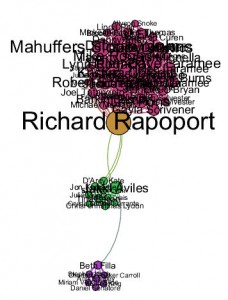 Do you know how it is when you find a new tool and suddenly it appears EVERYWHERE?! This is how I feel about relationship mapping. Ever since I purchased a subscription to Prospect Visual, I have started to notice different relationship mapping techniques and applications all over the place. My recent quest for facial recognition searches on photos is a case in point.
Do you know how it is when you find a new tool and suddenly it appears EVERYWHERE?! This is how I feel about relationship mapping. Ever since I purchased a subscription to Prospect Visual, I have started to notice different relationship mapping techniques and applications all over the place. My recent quest for facial recognition searches on photos is a case in point.
My typical nonprofit client doesn’t have a huge warehouse of internal data and often feels an urgency to add to its current donor pool to meet special fundraising initiatives. Relationship mapping holds such promise for identifying prospect gold in uncharted territories! Or does it? Yet?
My feel for the technologies involved is that it is early days. Some of what is currently being commercialized could be easily disrupted by what we might now consider ancillary or “extra” services. Facial recognition is a good example.
Technologies like facial recognition are both shockingly advanced and woefully inadequate. Most things start out expensive and, especially with technology, can become affordable in a remarkably short period of time. Here’s hoping that happens with facial recognition. Unless of course you are searching on me!
Here’s how my facial recognition quest began. I was working on a difficult prospect assignment. Not many donor lists out in the public domain in this particular city, and board members with limited profiles and middle-income wealth. And then I stumbled on a Flickr account with gala pictures from a past event of a similar organization. Eureka!
But no captions on the photos. And I am not personally familiar with the who’s who of that city. Bummer! Or is there a way? To find out I consulted the best talent around – the research list-serv hosted by APRA – and received two good sources:
Did you know that you could search for other images using an existing image? You can! And it did make good *exact* matches to find pages where my picture was located (because, of course, I tested it on myself first). But when it came to similar matches…wildly differing pictures appeared. But, ahem, it did find one of Julia Roberts, which I agree is very similar to mine.
This site seemed so promising, but it didn’t find any matches on my photo, which was disappointing.
These sites were not enough to help me identify the pictures on that Flickr account. But apparently there is some seriously powerful software available that has the potential to make a prospect researcher’s dream come true and find out way more than just linkage or connection.
Social media maven and all-around talented researcher, Lori Hood Lawson, pointed out a 60 Minutes episode that demonstrated the power of some maturing technologies – and has me even more determined to vote at every possible opportunity!
Check out the 60 Minutes episode here: http://www.cbsnews.com/video/watch/?id=50153673n
With the proliferation and popularity of photos and videos all over the public domain, it creates an opportunity not currently considered in the text-based products such as Prospect Visual and Relationship Science that are on the market for nonprofits right now.
Relationship mapping and other prospect research techniques often follow behind competitive intelligence and other for-profit efforts. The uses are similar, but not the same, and as prospect researchers, we often find ourselves getting “creative” to make products work for us. However, with the nonprofit industry growing to such a powerful size, we might see a shift.
But don’t worry donors, prospect researchers have a code of ethics we take incredibly seriously!
Other Articles You Might Like: Relationship Mapping for New Prospects
Join the Relationship Mapping Workgroup: Click Here to Sign Up
Questions? Want to talk about this post? Call Jen Filla at 727 202 3405 or email jen at aspireresearchgroup dot com.

